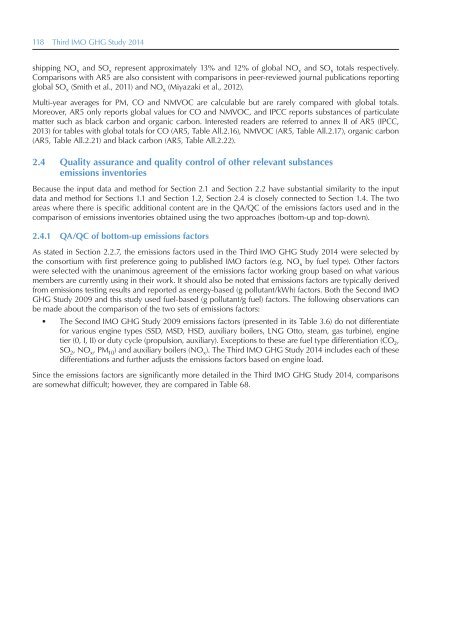Third IMO Greenhouse Gas Study 2014
GHG3%20Executive%20Summary%20and%20Report
GHG3%20Executive%20Summary%20and%20Report
Create successful ePaper yourself
Turn your PDF publications into a flip-book with our unique Google optimized e-Paper software.
118 <strong>Third</strong> <strong>IMO</strong> GHG <strong>Study</strong> <strong>2014</strong><br />
shipping NO x and SO x represent approximately 13% and 12% of global NO x and SO x totals respectively.<br />
Comparisons with AR5 are also consistent with comparisons in peer-reviewed journal publications reporting<br />
global SO x (Smith et al., 2011) and NO x (Miyazaki et al., 2012).<br />
Multi-year averages for PM, CO and NMVOC are calculable but are rarely compared with global totals.<br />
Moreover, AR5 only reports global values for CO and NMVOC, and IPCC reports substances of particulate<br />
matter such as black carbon and organic carbon. Interested readers are referred to annex II of AR5 (IPCC,<br />
2013) for tables with global totals for CO (AR5, Table All.2.16), NMVOC (AR5, Table All.2.17), organic carbon<br />
(AR5, Table All.2.21) and black carbon (AR5, Table All.2.22).<br />
2.4 Quality assurance and quality control of other relevant substances<br />
emissions inventories<br />
Because the input data and method for Section 2.1 and Section 2.2 have substantial similarity to the input<br />
data and method for Sections 1.1 and Section 1.2, Section 2.4 is closely connected to Section 1.4. The two<br />
areas where there is specific additional content are in the QA/QC of the emissions factors used and in the<br />
comparison of emissions inventories obtained using the two approaches (bottom-up and top-down).<br />
2.4.1 QA/QC of bottom-up emissions factors<br />
As stated in Section 2.2.7, the emissions factors used in the <strong>Third</strong> <strong>IMO</strong> GHG <strong>Study</strong> <strong>2014</strong> were selected by<br />
the consortium with first preference going to published <strong>IMO</strong> factors (e.g. NO x by fuel type). Other factors<br />
were selected with the unanimous agreement of the emissions factor working group based on what various<br />
members are currently using in their work. It should also be noted that emissions factors are typically derived<br />
from emissions testing results and reported as energy-based (g pollutant/kWh) factors. Both the Second <strong>IMO</strong><br />
GHG <strong>Study</strong> 2009 and this study used fuel-based (g pollutant/g fuel) factors. The following observations can<br />
be made about the comparison of the two sets of emissions factors:<br />
• The Second <strong>IMO</strong> GHG <strong>Study</strong> 2009 emissions factors (presented in its Table 3.6) do not differentiate<br />
for various engine types (SSD, MSD, HSD, auxiliary boilers, LNG Otto, steam, gas turbine), engine<br />
tier (0, I, II) or duty cycle (propulsion, auxiliary). Exceptions to these are fuel type differentiation (CO 2 ,<br />
SO 2 , NO x , PM 10 ) and auxiliary boilers (NO x ). The <strong>Third</strong> <strong>IMO</strong> GHG <strong>Study</strong> <strong>2014</strong> includes each of these<br />
differentiations and further adjusts the emissions factors based on engine load.<br />
Since the emissions factors are significantly more detailed in the <strong>Third</strong> <strong>IMO</strong> GHG <strong>Study</strong> <strong>2014</strong>, comparisons<br />
are somewhat difficult; however, they are compared in Table 68.


